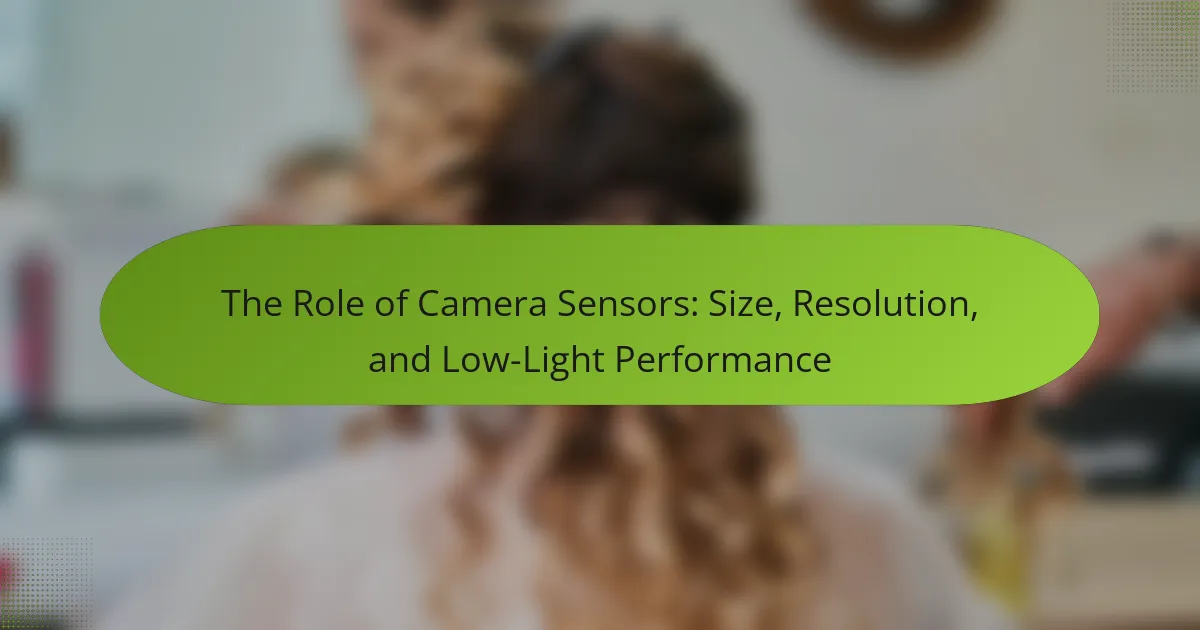Camera sensors are critical components in photography, responsible for capturing light and converting it into electrical signals that create images. The size of the sensor significantly influences image quality, detail, and low-light performance, with larger sensors typically providing superior results. Resolution, defined by the number of pixels, directly affects the sharpness and detail of photographs, allowing for larger prints and greater post-processing flexibility. Additionally, advancements in sensor technology, such as back-illuminated designs, enhance low-light capabilities and dynamic range. This article explores the intricate relationship between sensor size, resolution, and low-light performance, highlighting their importance in achieving high-quality photographic outcomes.
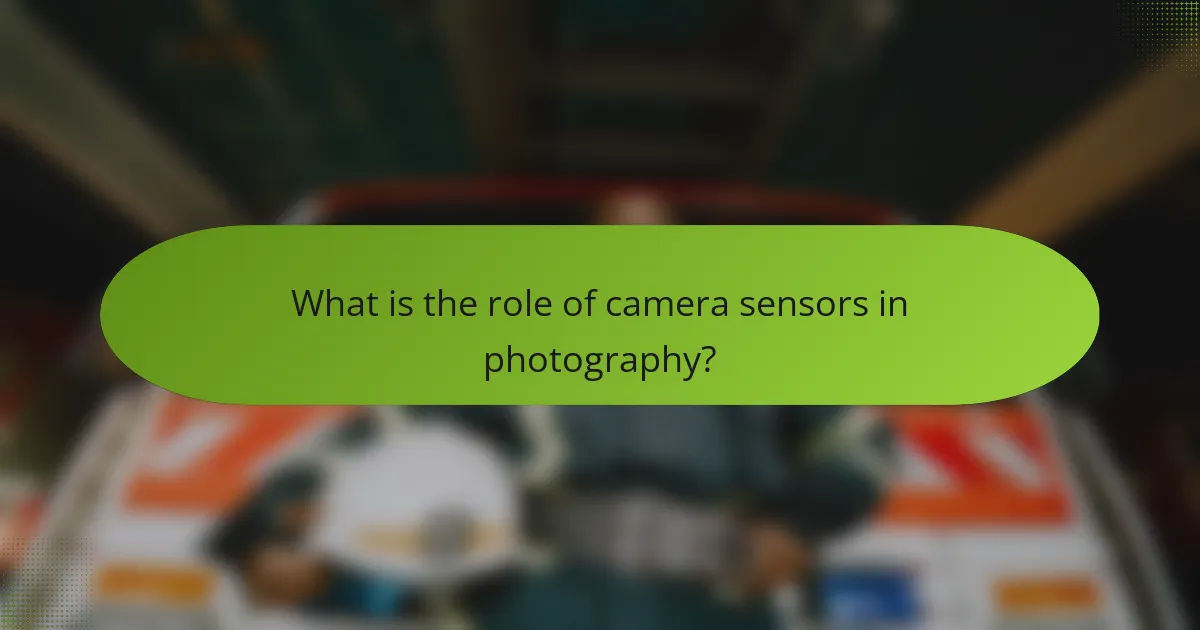
What is the role of camera sensors in photography?
Camera sensors capture light and convert it into electrical signals, forming the basis of image creation in photography. They determine the quality, detail, and color accuracy of the final image. The size of the sensor affects the depth of field and low-light performance. Larger sensors typically yield better image quality, especially in dim conditions. Resolution, measured in megapixels, influences the detail captured in an image. Higher resolution allows for larger prints and more cropping flexibility. Additionally, sensor technology impacts dynamic range, which affects how well a camera can handle highlights and shadows. Overall, camera sensors are crucial for achieving desired photographic outcomes.
How do camera sensors capture light and image data?
Camera sensors capture light and image data through a process called photodetection. When light enters the camera, it passes through the lens and reaches the sensor. The sensor is made up of millions of tiny pixels, each capable of detecting light.
These pixels convert incoming photons into electrical signals. The intensity of light hitting each pixel determines the strength of the electrical signal produced. This process generates a digital representation of the scene.
The camera’s analog-to-digital converter then processes these signals. It transforms them into digital data that the camera can use to create an image. This entire mechanism allows for capturing detailed images based on the light information received.
What are the main components of a camera sensor?
The main components of a camera sensor are the photodiodes, micro-lenses, and color filters. Photodiodes convert light into electrical signals. Micro-lenses focus light onto the photodiodes to enhance sensitivity. Color filters are used to capture color information by allowing specific wavelengths of light to pass through. These components work together to capture the image effectively. The arrangement and quality of these components significantly influence image quality and sensor performance.
How does light sensitivity affect image capture?
Light sensitivity directly influences image capture by determining how well a camera sensor can detect and record light. High light sensitivity allows sensors to produce clearer images in low-light conditions. Conversely, low light sensitivity leads to grainy or poorly exposed images when lighting is inadequate. For example, sensors with higher ISO ratings can capture more detail in dim environments. Research indicates that modern sensors can achieve ISO levels exceeding 100,000, significantly improving low-light performance. This capability is crucial for photography in various settings, such as night scenes or indoor events.
What factors influence the performance of camera sensors?
The performance of camera sensors is influenced by several key factors. These include sensor size, resolution, pixel size, dynamic range, and low-light sensitivity. Larger sensors typically capture more light, improving image quality. Higher resolution allows for more detail in images. Larger pixels can gather more light, which enhances performance in low-light conditions. Dynamic range affects the sensor’s ability to capture details in both bright and dark areas. Additionally, the sensor’s technology, such as CMOS or CCD, also plays a significant role in its overall performance. Each of these factors contributes to the final image quality produced by the camera sensor.
How does sensor size impact image quality?
Sensor size significantly impacts image quality. Larger sensors typically capture more light. This results in better detail and less noise. For example, full-frame sensors outperform crop sensors in low-light conditions. They produce clearer images with greater dynamic range. A study by DxOMark shows that larger sensors yield higher ISO performance. This means they maintain image quality at higher sensitivities. Smaller sensors may struggle with noise and detail retention. Therefore, sensor size is crucial for achieving optimal image quality.
What is the relationship between resolution and detail in images?
Resolution directly influences the level of detail in images. Higher resolution means more pixels are used to create an image. Each pixel represents a specific part of the scene being captured. Therefore, more pixels allow for finer details to be displayed. For instance, a 12-megapixel image has more detail than a 2-megapixel image. This is because the 12-megapixel image can capture smaller features and textures. Additionally, higher resolution images can be enlarged without losing clarity. This relationship is critical in photography and digital imaging. Studies show that images with higher resolution are perceived as sharper and more detailed by viewers.
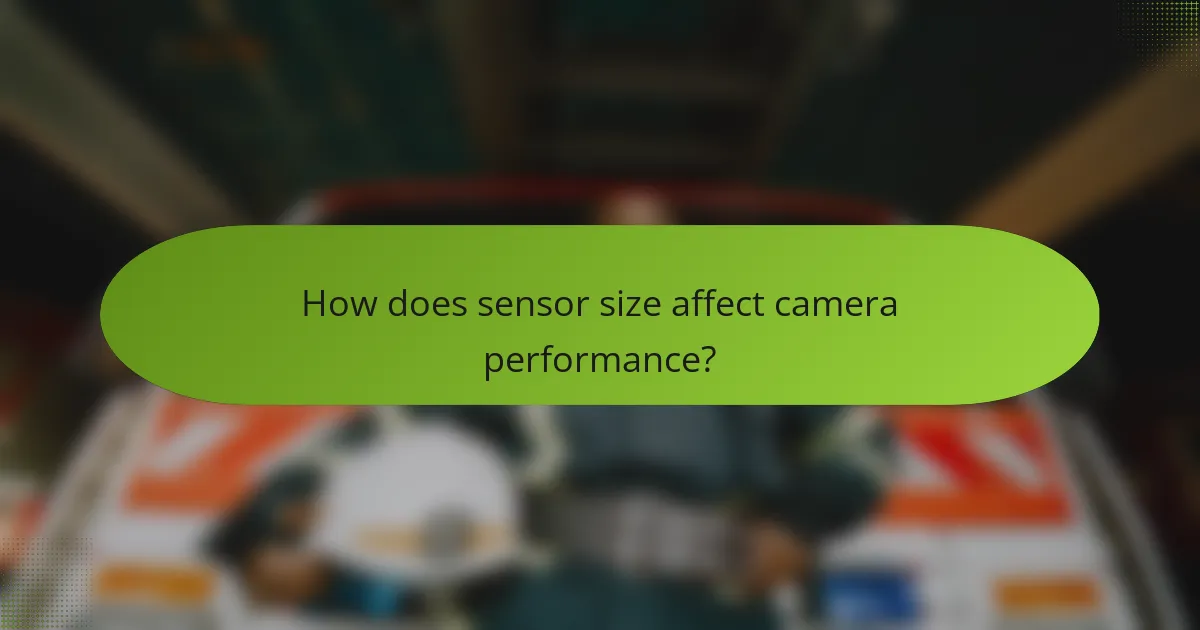
How does sensor size affect camera performance?
Sensor size significantly affects camera performance. Larger sensors capture more light, resulting in better image quality. They produce less noise at high ISO settings. This is crucial for low-light photography. Additionally, larger sensors offer a shallower depth of field. This allows for better subject isolation. For instance, full-frame sensors outperform crop sensors in dynamic range. A study by DxOMark shows that larger sensors have higher overall scores in image quality metrics. Thus, sensor size is a key factor in determining camera performance.
What are the different sizes of camera sensors?
Camera sensors come in various sizes, each affecting image quality and performance. Common sensor sizes include Full Frame (35mm), APS-C, Micro Four Thirds, and 1-inch sensors. Full Frame sensors measure approximately 36mm x 24mm. APS-C sensors typically measure around 22mm x 15mm. Micro Four Thirds sensors are about 17mm x 13mm. 1-inch sensors have dimensions of approximately 13.2mm x 8.8mm. Each size influences depth of field, low-light capability, and lens compatibility. Larger sensors generally provide better image quality and performance in low light.
What are the advantages of larger sensor sizes?
Larger sensor sizes offer several advantages in photography. They capture more light, resulting in better image quality. This leads to improved low-light performance, reducing noise in images. Larger sensors also provide a greater dynamic range, allowing for more detail in highlights and shadows. Additionally, they enable shallower depth of field, which helps in achieving a more pronounced background blur. This effect enhances subject isolation in portraits. Furthermore, larger sensors can produce higher resolution images, accommodating larger prints without loss of detail. Overall, these advantages contribute to superior photographic outcomes.
How do smaller sensors compare in terms of portability?
Smaller sensors are generally more portable than larger sensors. Their compact size allows for easier integration into lightweight camera systems. This portability makes smaller sensors ideal for travel and on-the-go photography. Many compact cameras and smartphones utilize smaller sensors for this reason. Additionally, smaller sensors often contribute to a reduced overall camera weight. This can enhance user comfort during extended use. The trend toward miniaturization in technology further supports the portability of smaller sensors. Thus, smaller sensors are favored for their convenience and ease of transport.
Why is sensor size important for low-light performance?
Sensor size is important for low-light performance because larger sensors can capture more light. This increased light capture results in better image quality in dim conditions. Larger sensors have bigger individual pixels, which can gather more photons. More photons lead to improved signal-to-noise ratios. This means less noise and clearer images in low light. For example, full-frame sensors typically perform better than crop sensors in low-light scenarios. Studies show that cameras with larger sensors often produce images with less grain and more detail. Hence, sensor size directly influences low-light image quality and performance.
How does sensor size influence noise levels in images?
Larger sensor sizes generally produce lower noise levels in images. This is because larger sensors can capture more light. Increased light capture leads to better signal-to-noise ratios. A higher signal-to-noise ratio results in clearer images with less grain. For example, full-frame sensors typically outperform crop sensors in low-light conditions. Studies indicate that sensors with larger dimensions can handle high ISO settings more effectively. This capability minimizes noise during image capture. Thus, sensor size directly influences the quality of images in terms of noise levels.
What role does pixel size play in low-light conditions?
Pixel size significantly impacts low-light performance in cameras. Larger pixels can capture more light compared to smaller pixels. This increased light-gathering ability results in better image quality in dim conditions. For instance, a pixel size of 2.0 micrometers can collect more photons than a 1.0 micrometer pixel. As a result, images taken in low light with larger pixels exhibit less noise and greater detail. Studies show that sensors with larger pixels can achieve better dynamic range and color accuracy in low-light environments. Therefore, pixel size is crucial for enhancing camera performance in challenging lighting situations.
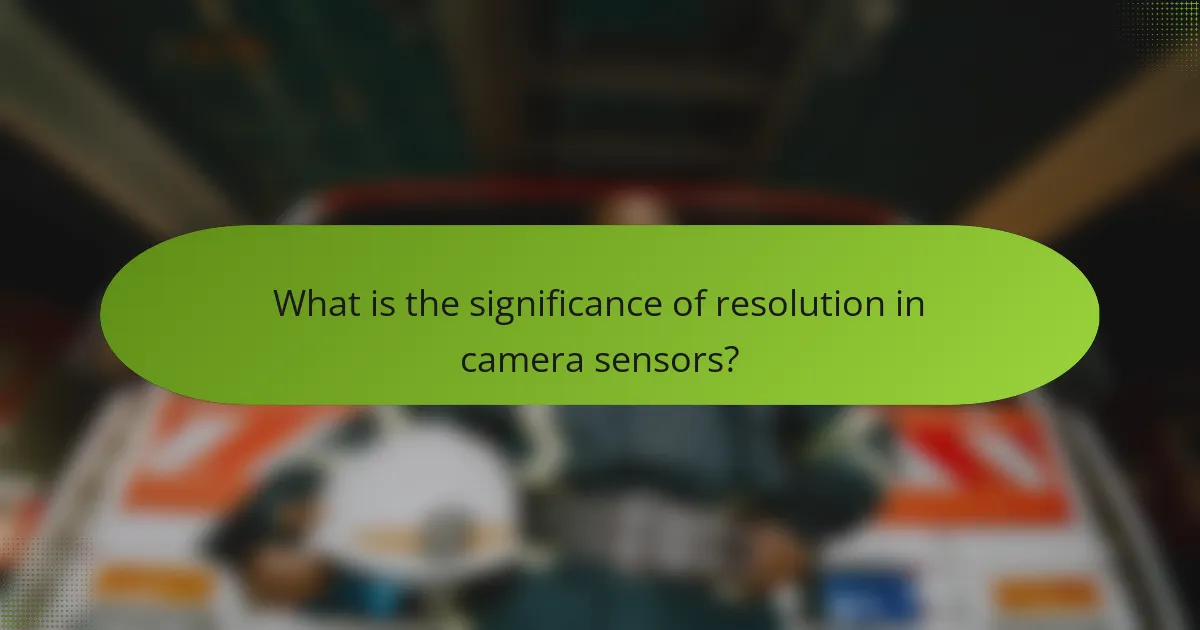
What is the significance of resolution in camera sensors?
Resolution in camera sensors refers to the amount of detail an image can hold. Higher resolution means more pixels are used to capture an image. This results in sharper and more detailed photographs. For example, a 20-megapixel sensor captures images with 20 million pixels. In contrast, a 10-megapixel sensor captures only 10 million pixels.
Higher resolution is particularly significant for large prints and cropping images without losing detail. It allows for greater flexibility in post-processing. Additionally, resolution impacts how images are displayed on various screens. Higher resolution sensors are preferred for professional photography and high-quality video production.
How does resolution affect image clarity?
Resolution directly affects image clarity by determining the amount of detail captured in an image. Higher resolution means more pixels, which allows for finer details and sharper images. For example, a 12-megapixel image can capture more detail than a 6-megapixel image. This increase in pixel count translates to better clarity, especially when images are enlarged.
Additionally, higher resolution images reduce the appearance of pixelation. Pixelation occurs when images are enlarged beyond their resolution capabilities. Studies show that images with higher resolution maintain clarity even at larger sizes. Therefore, resolution is a critical factor in achieving clear and detailed images.
What are the common resolutions found in modern cameras?
Common resolutions found in modern cameras include 12 MP, 16 MP, 24 MP, 32 MP, and 48 MP. These resolutions are standard in consumer and professional cameras. The 12 MP resolution is typical for entry-level models. The 24 MP resolution is common in mid-range DSLRs and mirrorless cameras. Higher-end models often feature 32 MP or 48 MP resolutions. These higher resolutions allow for greater detail in images. For instance, 24 MP can produce high-quality prints up to 20×30 inches. The trend in camera technology shows a move toward higher resolutions for better image quality.
How does resolution impact file size and storage needs?
Resolution directly impacts file size and storage needs. Higher resolution images contain more pixels, which increases the amount of data stored. For example, a 12-megapixel image is significantly larger than a 3-megapixel image. This is because the 12-megapixel image has four times the number of pixels. Consequently, more pixels require more storage space. File formats also influence size; uncompressed formats like RAW are larger than compressed formats like JPEG. For instance, a RAW file from a 20-megapixel camera can exceed 25 MB, while a JPEG of the same image might be around 5 MB. Thus, as resolution increases, so do the file size and storage requirements.
What are the limitations of high-resolution sensors?
High-resolution sensors have several limitations. One significant limitation is increased data storage requirements. High-resolution images consume more storage space due to larger file sizes. Another limitation is slower processing speeds. The increased amount of data can lead to longer processing times in cameras. Additionally, high-resolution sensors may produce more noise in low-light conditions. This noise can degrade image quality, making it less desirable for certain applications. Furthermore, high-resolution sensors can be more expensive to manufacture. The cost of high-resolution technology can limit accessibility for some users. Lastly, high-resolution sensors may require better optics to fully utilize their capabilities. Inferior lenses can result in image quality that does not match the sensor’s potential.
How do high resolutions affect processing speed?
High resolutions can negatively affect processing speed. Higher resolutions require more data to be processed. This increased data load can lead to longer processing times. For instance, a 4K image has four times the pixel count of a 1080p image. Consequently, the camera’s processor must work harder to handle this data. This can result in slower frame rates and longer image processing times. Additionally, complex algorithms used for high-resolution images can further strain processing capabilities. Therefore, while high resolutions improve image detail, they can hinder processing speed.
What challenges arise with higher resolution in low-light situations?
Higher resolution in low-light situations leads to increased noise and reduced sensitivity. Higher pixel counts can result in smaller individual pixels. Smaller pixels capture less light, which affects image quality. Noise becomes more prominent as the signal-to-noise ratio decreases. This results in grainy images that lack detail. Additionally, higher resolution demands more processing power. This can slow down camera performance in low-light scenarios. Research indicates that noise levels can increase significantly with pixel density. Thus, balancing resolution and low-light performance is crucial for optimal image quality.
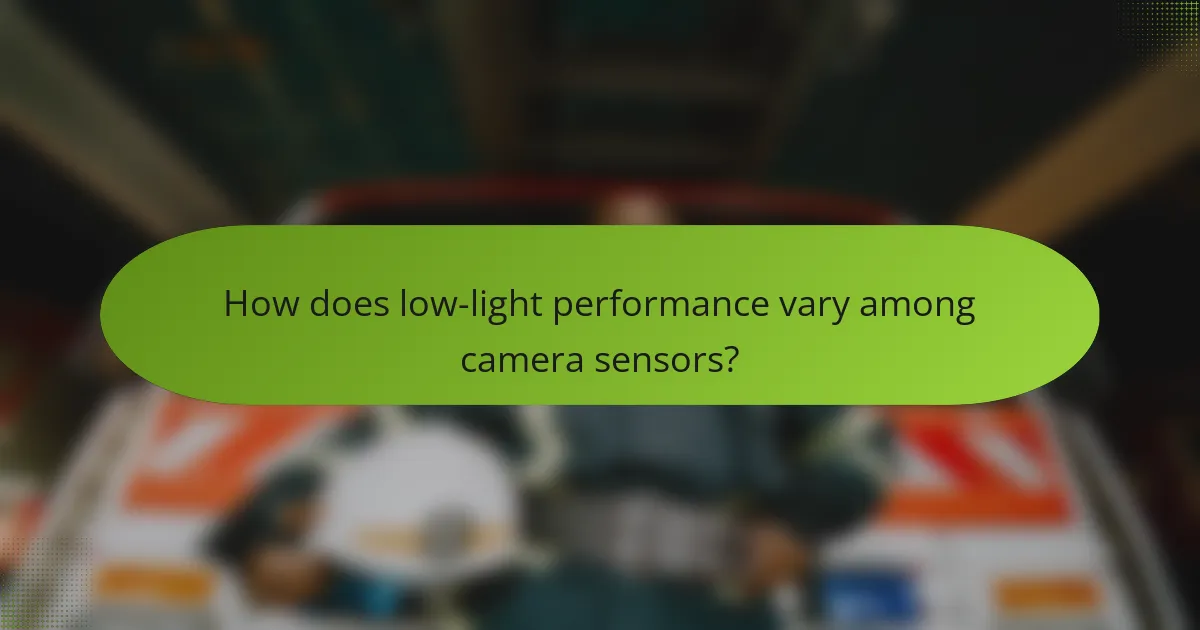
How does low-light performance vary among camera sensors?
Low-light performance varies significantly among camera sensors based on their size, technology, and design. Larger sensors generally capture more light, resulting in better low-light performance. For instance, full-frame sensors outperform crop sensors in low-light situations due to their greater surface area. Additionally, sensors with larger individual pixels can gather more light, enhancing low-light capabilities.
Technologies like back-illuminated (BSI) sensors improve low-light performance by reducing light loss during capture. Research has shown that BSI sensors can increase sensitivity by up to 60% compared to traditional sensors. Noise reduction algorithms also play a crucial role in enhancing low-light image quality.
In summary, sensor size, pixel design, and technological advancements directly influence low-light performance in cameras.
What factors contribute to a sensor’s low-light capabilities?
Sensor size, pixel size, and sensor technology contribute to a sensor’s low-light capabilities. Larger sensors can capture more light, improving performance in dim conditions. Increased pixel size allows individual pixels to gather more light, enhancing sensitivity. Advanced sensor technologies, such as back-illuminated sensors, improve light collection efficiency. Noise reduction techniques further enhance image quality in low-light settings. These factors collectively determine how well a sensor performs under low-light conditions.
How does sensor technology influence low-light performance?
Sensor technology significantly influences low-light performance in cameras. Larger sensors typically capture more light due to their increased surface area. This results in improved image quality and reduced noise in low-light conditions. Additionally, advancements in sensor sensitivity, such as higher ISO capabilities, enhance performance in dim environments. Specific technologies like back-illuminated (BSI) sensors improve light capture efficiency. BSI sensors allow more light to reach the photodiodes, leading to clearer images at lower light levels. Research indicates that cameras with larger, more sensitive sensors outperform their smaller counterparts in low-light scenarios. For example, full-frame sensors often yield better results than crop sensors in similar conditions.
What are the benefits of advanced low-light sensor designs?
Advanced low-light sensor designs enhance image quality in dim conditions. They improve sensitivity to light, allowing for clearer images with less noise. These sensors often feature larger pixel sizes, which capture more light. Enhanced dynamic range is another benefit, providing better detail in shadows and highlights. Advanced algorithms in these sensors reduce motion blur during low-light capture. They enable faster autofocus, crucial in low-light scenarios. Many modern sensors support higher ISO settings without introducing significant grain. Overall, these advancements lead to superior performance in challenging lighting conditions.
What techniques can enhance low-light photography?
Using a wide aperture is a key technique to enhance low-light photography. A larger aperture allows more light to reach the camera sensor. This results in brighter images in dim conditions. Additionally, increasing the ISO setting improves the sensor’s sensitivity to light. However, higher ISO settings can introduce noise, so balance is essential.
Using a slower shutter speed also captures more light. A tripod can help stabilize the camera during longer exposures. This prevents motion blur and keeps images sharp. Lastly, utilizing external lighting sources, like flash or LED lights, can significantly improve illumination.
These techniques are widely recognized in photography for their effectiveness in low-light scenarios.
How can photographers optimize settings for low-light conditions?
Photographers can optimize settings for low-light conditions by adjusting the ISO, aperture, and shutter speed. Increasing the ISO sensitivity allows the camera to capture more light, but can introduce noise. A wider aperture (lower f-stop number) lets in more light, enhancing exposure. Slower shutter speeds can also increase light exposure, but may cause motion blur if the camera moves. Using a tripod stabilizes the camera during longer exposures. Additionally, utilizing manual focus can improve clarity in low-light environments. These adjustments collectively enhance image quality in challenging lighting conditions.
What equipment is best for improving low-light image capture?
A fast lens with a wide aperture is best for improving low-light image capture. Lenses with an aperture of f/1.8 or wider allow more light to reach the sensor. This increased light intake enhances image clarity in dim conditions. Additionally, using a camera with a larger sensor size can improve low-light performance. Larger sensors typically capture more light and produce less noise. A camera with high ISO capabilities also aids in low-light situations. High ISO settings allow for faster shutter speeds without sacrificing image quality. Stabilization features, such as in-body image stabilization, help reduce motion blur. These features collectively enhance the ability to capture clear images in low-light environments.
The main entity of this article is camera sensors, which are critical components in photography that capture light and convert it into electrical signals to create images. The article explores the role of sensor size, resolution, and low-light performance, detailing how these factors influence image quality, detail, and color accuracy. Key components of camera sensors, such as photodiodes and pixel size, are examined, along with their impact on low-light capabilities and noise levels. Additionally, the article discusses techniques for optimizing camera settings to enhance performance in challenging lighting conditions, providing a comprehensive understanding of how camera sensors affect photographic outcomes.
